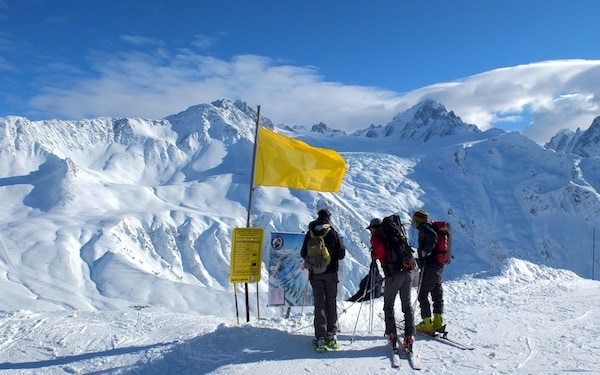
The runs outlined below are some of my favourites. I’ve shown where they are and what you need to take in terms of equipment, but the most important element of your day is a mountain guide to show you the way. The Guide bureaux in Chamonix and Courmayeur are the oldest in the world (founded in 1821 and 1850 respectively) and the men and women who work there are at the top of their profession. If you’re heading away from the marked runs and into these beautiful but potentially dangerous mountains make sure you take a professional.
Let’s start in Italy – Courmayeur is sometimes referred to as the “sunny side” of Mont Blanc due to the fact that it’s further south than Chamonix, but it gets just as much fearsome weather as its northern neighbour. In fact this is one of the advantages of the entire region: if it’s dumping down in France in can often be clear blue skies in Italy and vice versa, so keep your eye on the webcams. Almost all of these runs involve descents of 1000m to 1300m in all kinds of snow conditions, so be prepared for some serious exercise.
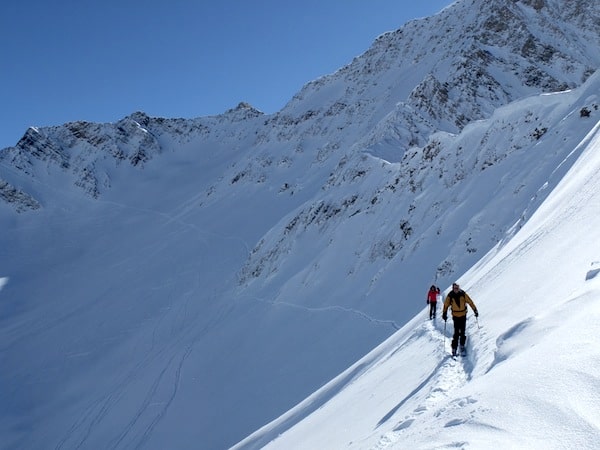
1. Arp Vieille (or “old meadow” in the local dialect)
This is a fabulous run that starts at the top of the Cresta d’Arp cable-car at 2755m, the top of Courmayeur’s main ski area. Head out west on a downhill traverse towards a small col, from here you have to negotiate a diagonal gulley that takes you across to the start of the uphill section that will bring you to the Arp Vieille itself. This climb can be done with skins or as a long sidestep but either way it’ll take you 15 to 20 minutes of huffing and puffing to emerge onto a ridge with the most extraordinary views of the southern flank of Mont Blanc.
From the French border on your left to the Swiss one 25km away down the valley to your right, this panorama takes in the dozens of peaks and glaciers that form the northern ramparts of Italy.
From here there’s a choice of glorious open meadows and wooded glades, very often covered in fresh powder, that take you on the long descent to the narrow valley floor. Then the summer road takes you through a deserted pine forest to the base of the Zerotta ski-lift at 1524m where civilisation, in terms of sunny terraces, delicious food and a comfy chair-lift, starts again.
What to take: Rucksack with a shovel and probe, avalanche transceiver and a small picnic to enjoy at the summit of the climb to Arp Vieille itself.
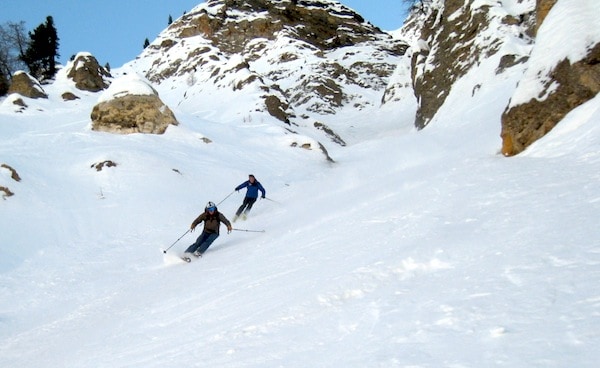
2.The Canale del Vescovo (or Bishops’s Couloir)
Another classic descent that’s a little away from the better known off-piste descents in Courmayeur’s main ski area. Again the start point is normally the top of Cresta d’Arp cablecar however you can also access it via the Youla lift. Instead of heading left and up to Arp Vieille (see above) from the main bowl below the two cable-car stations bear left under the col, you climb to access Arp Vieille and you’ll find a short steep bowl under a large cliff. On the right you’ll see a rocked shaped exactly like a Bishop’s mitre (hence the name of the run). Bear left and then sharp right into a steep (35°) couloir that narrows to a width of just four metres between the huge granite rocks that line this part of the descent.
Once clear of this tight section the couloir opens into a perfectly pitched tree-lined avenue that drops you, after a few hundred turns often in glorious powder, down to the dark, silent, valley floor. Again the summer road will take you back to the left station of Zerotta where you get back into the lift system and head back out for your next descent.
What to take: Rucksack with a shovel and probe, avalanche transceiver and extendable ski poles for the road back.
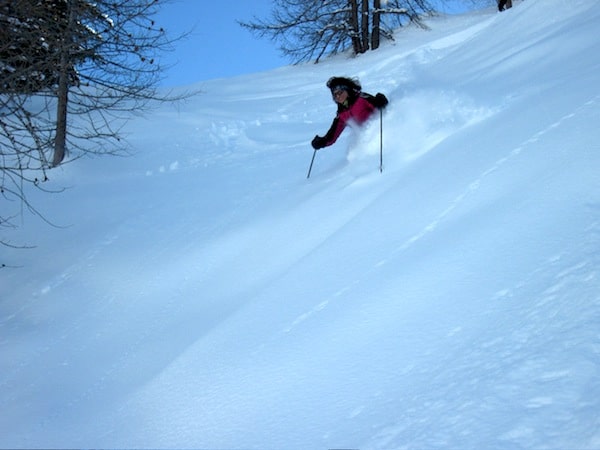
3. Arp Dolonne via the Canale Dolonne
A long testing descent that again starts at the top station of the Cresta d’Arp cable-car. Heading south from the cable-car, chose the safest route (depending on the conditions) to descend the first steep slope towards the Youla Col. From here you take one of the many gullies that lead to a huge powder-filled amphitheatre that feels like it’s a million miles from the nearest piste. Head towards the left of this massive bowl until you find the very steep entry to the Canale Dolonne. Negotiate this and you’ll end up in another massive bowl, although this one is much steeper, and follow the natural progression to the narrow gully that takes you back towards the hamlet of Dolonne.
This gully follows the path of a frozen river and can be tricky, so be prepared for lots of side-slipping down frozen waterfalls and planting exact turns between the massive boulders that line the river bed. Eventually you’ll see the orange netting of a ski run in the forest above you, climb up a couple of metres to this and you’ll pop out like Doctor Who from the Tardis onto a gentle blue run that takes you back to the main Dolonne gondola station 1,500m below where you started this classic descent.
What to take: Rucksack with a shovel and probe, avalanche transceiver and a spare set of gloves! If you miss a turn in the lower section its easy to end up face first (or worse) in one of the many small pools of icy water that lurk beneath the snow!
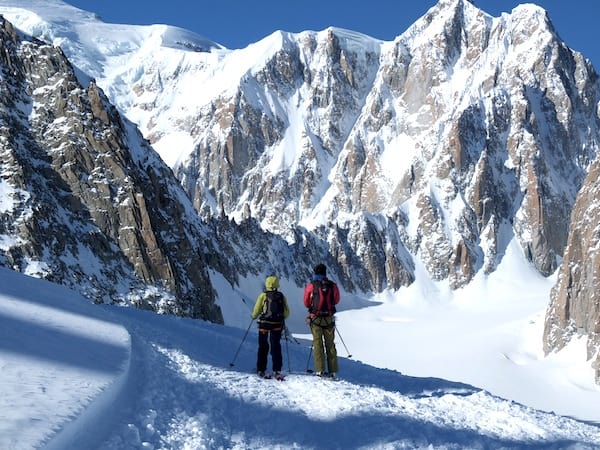
4. The Toula Glacier
This is one of Courmayeur’s most famous descents and is a big day out by anyone’s reckoning. You need to drive for 10 minutes from Courmayeur (or take the local bus) to the hamlet of La Palud near the entrance to Mont Blanc Tunnel and take the old two-stage cable-car to the Rifugio Torino at 3329m. Here you can take in the extraordinary views and fortify yourself in the refuge bar with fresh brioches and a piping hot, chocolate-topped cappuccino. A brand new cable-car system is currently being built here and will open in 2015, but for now you have to climb 50m up a very steep stone staircase to emerge blinking in the sunlight on the terrace of another old, deserted refuge. From here you have either skin or walk round for 20 minutes over the Col Flambeaux to the real start of the descent. This might seem like a pain, but with the incredible views of Mont Blanc’s most spectacular canyons laid out before you, you’ll hardly notice the walk.
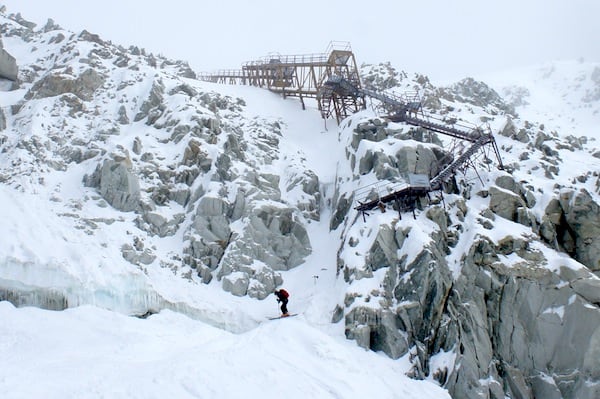
A short, steep, icy gully takes you to the top of infamous Toula steps, a steep metal staircase bolted to the side of the mountain that takes you down to the glacier itself. In the past you could ski straight from the end of the steps but as the glacier has retreated you now have climb down an additional stepladder to a small snow terrace where you gingerly put your skis on and finally start the real skiing section of the day.
There are multiple variations of this descent but all of them involve wide-open snowfields crisscrossed with crevasses, so a local guide is essential. The descents get progressively steeper as you pass between some massive icefalls that have to be carefully negotiated.
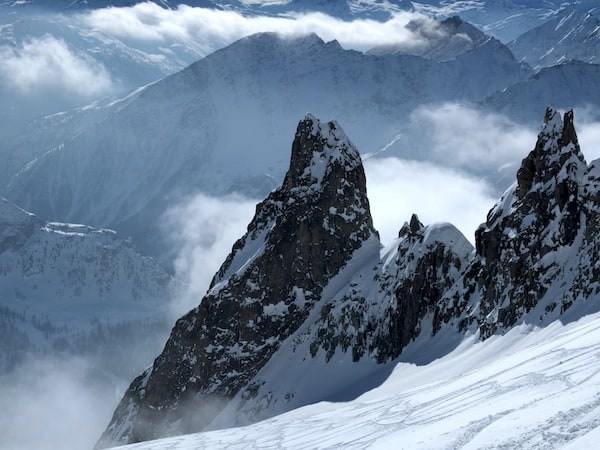
Once past this section you generally head to skiers left over a series huge rollers that eventually take you down to the Mont Frety Refuge and lift station at 2178m where your reward for all the effort awaits. The restaurant at this refuge is outstanding – we’re talking some of the best food you’ll find anywhere in the Alps.
If you start early enough you can do a couple of different runs on the Toula glacier however, as the whole area is south-facing, it’s generally safer to only ski in the morning. The avalanche danger increases in the afternoon and to be honest once you’ve done two, or even three descents, you’ll be ready for some rest and relaxation. Whether you choose the restaurant or the fabulous sunny terrace for an afternoon doze you’ll be in the company of some of the world’s best skiers, many of whom are regular visitors to both the glaciers on the Italian side of Mont Blanc and the Mont Frety Refuge.
What to take: Rucksack with a shovel and probe, avalanche transceiver, harness, carabiners and a rope. Whilst your guide will certainly have the rope it’s essential that you’re properly equipped when skiing on glaciers. The crevasses are ever-present and constantly moving. This is a tough run that requires good fitness both for the skiing itself and the climbs up and down the staircases, which at altitude can be very taxing.
Next week I’ll be looking at the main Mont Blanc range, plus the Chamonix Valley.
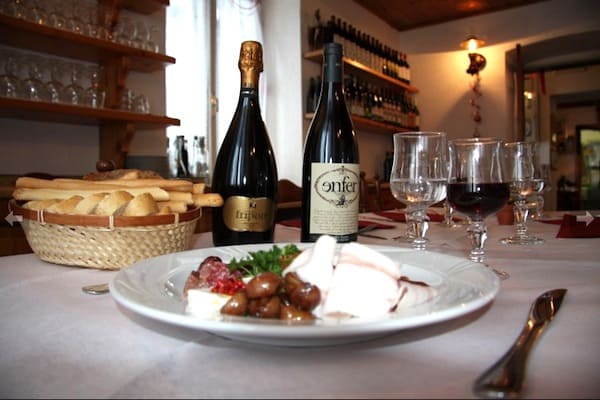










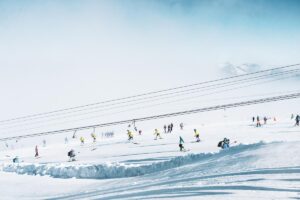
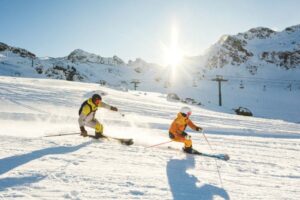
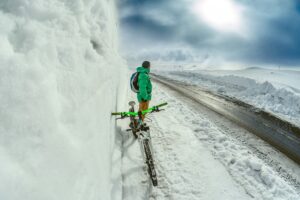
Magnificent post from our man in Courmayeur: best off-piste descents on the Mont Blanc massif. https://t.co/XguVErLlLc https://t.co/kt9Oku7EZn
Have you read Paddy O’Powder’s blog on big Mont Blanc descents yet? The product of many days in gob-smacking places https://t.co/XguVErLlLc
RT @welove2ski: Have you read Paddy O’Powder’s blog on big Mont Blanc descents yet? The product of many days in gob-smacking places http …
“There are of course many great ski areas around the world, but few come close to the mind-blowing range of… https://t.co/Ry3sKau7pl
RT @SkiInCourmayeur: “There are of course many great ski areas around the world, but few come close to the mind-blowing range of… http …